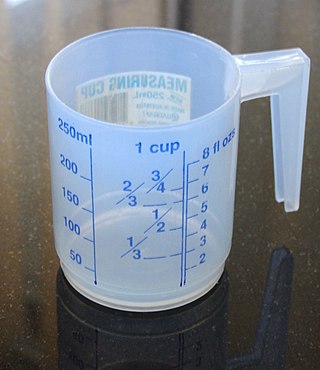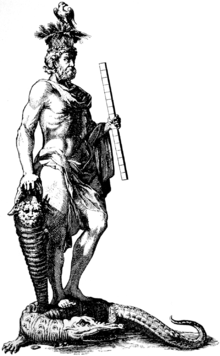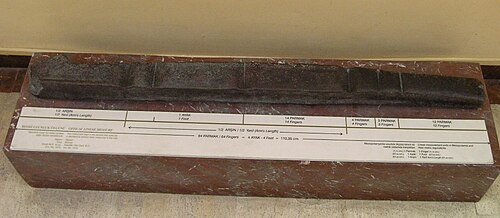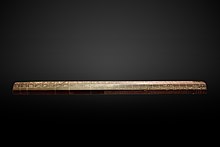
Volume is a measure of regions in three-dimensional space. It is often quantified numerically using SI derived units or by various imperial or US customary units. The definition of length (cubed) is interrelated with volume. The volume of a container is generally understood to be the capacity of the container; i.e., the amount of fluid that the container could hold, rather than the amount of space the container itself displaces. By metonymy, the term "volume" sometimes is used to refer to the corresponding region.

A ruler, sometimes called a rule, scale or a line gauge, is an instrument used to make length measurements, whereby a user estimates a length by reading from a series of markings called "rules" along an edge of the device. Commonly the instrument is rigid and the edge itself is a straightedge, which additionally allows one to draw straight lines. Some rulers, such as cloth or paper tape measures, are non-rigid. Specialty rulers exist that have flexible edges that retain a chosen shape; these find use in sewing, arts, and crafts.

The cubit is an ancient unit of length based on the distance from the elbow to the tip of the middle finger. It was primarily associated with the Sumerians, Egyptians, and Israelites. The term cubit is found in the Bible regarding Noah's Ark, the Ark of the Covenant, the Tabernacle, and Solomon's Temple. The common cubit was divided into 6 palms × 4 fingers = 24 digits. Royal cubits added a palm for 7 palms × 4 fingers = 28 digits. These lengths typically ranged from 44.4 to 52.92 cm, with an ancient Roman cubit being as long as 120 cm.
The foot (pl. feet), standard symbol: ft, is a unit of length in the British imperial and United States customary systems of measurement. The prime symbol, ′, is a customarily used alternative symbol. In both customary and imperial units, one foot comprises 12 inches, and one yard comprises three feet.

The hand is a non-SI unit of measurement of length standardized to 4 in (101.6 mm). It is used to measure the height of horses in many English-speaking countries, including Australia, Canada, the Republic of Ireland, the United Kingdom, and the United States. It was originally based on the breadth of a human hand. The adoption of the international inch in 1959 allowed for a standardized imperial form and a metric conversion. It may be abbreviated to "h" or "hh". Although measurements between whole hands are usually expressed in what appears to be decimal format, the subdivision of the hand is not decimal but is in base 4, so subdivisions after the radix point are in quarters of a hand, which are inches. Thus, 62 inches is fifteen and a half hands, or 15.2 hh.

A unit of length refers to any arbitrarily chosen and accepted reference standard for measurement of length. The most common units in modern use are the metric units, used in every country globally. In the United States the U.S. customary units are also in use. British Imperial units are still used for some purposes in the United Kingdom and some other countries. The metric system is sub-divided into SI and non-SI units.

A tape measure or measuring tape is a flexible ruler used to measure length or distance.
The rod, perch, or pole is a surveyor's tool and unit of length of various historical definitions. In British imperial and US customary units it is defined as 16+1⁄2 feet, equal to exactly 1⁄320 of a mile, or 5+1⁄2 yards, and is exactly 5.0292 meters. The rod is useful as a unit of length because integer multiples of it can form one acre of square measure (area). The 'perfect acre' is a rectangular area of 43,560 square feet, bounded by sides 660 feet long and 66 feet wide or, equivalently, 40 rods by 4 rods. An acre is therefore 160 square rods or 10 square chains.
The megalithic yard is a hypothetical ancient unit of length equal to about 2.72 feet (0.83 m). Some researchers believe it was used in the construction of megalithic structures. The proposal was made by Alexander Thom as a result of his surveys of 600 megalithic sites in England, Scotland, Wales and Brittany. Thom also proposed the megalithic rod of 2.5 megalithic yards, or on average across sites 6.77625 feet. As subunits of these, he further proposed the megalithic inch of 2.073 centimetres (0.816 in), one hundred of which are included in a megalithic rod, and forty of which composed a megalithic yard. Thom applied the statistical lumped variance test of J.R. Broadbent on this quantum and found the results significant, while others have challenged his statistical analysis and suggested that Thom's evidence can be explained in other ways, for instance that the supposed megalithic yard is in fact the average length of a pace.

Gunter's chain is a distance measuring device used for surveying. It was designed and introduced in 1620 by English clergyman and mathematician Edmund Gunter (1581–1626). It enabled plots of land to be accurately surveyed and plotted, for legal and commercial purposes.

The digit or finger is an ancient and obsolete non-SI unit of measurement of length. It was originally based on the breadth of a human finger. It was a fundamental unit of length in the Ancient Egyptian, Mesopotamian, Hebrew, Ancient Greek and Roman systems of measurement.

The palm is an obsolete anthropic unit of length, originally based on the width of the human palm and then variously standardized. The same name is also used for a second, rather larger unit based on the length of the human hand.
The ancient Egyptian units of measurement are those used by the dynasties of ancient Egypt prior to its incorporation in the Roman Empire and general adoption of Roman, Greek, and Byzantine units of measurement. The units of length seem to have originally been anthropic, based on various parts of the human body, although these were standardized using cubit rods, strands of rope, and official measures maintained at some temples.
A knotted cord was a primitive surveyor's tool for measuring distances. It is a length of cord with knots at regular intervals. They were eventually replaced by surveyor's chains, which being made of metal were less prone to stretching and thus were more accurate and consistent.

The earliest recorded systems of weights and measures originate in the 3rd or 4th millennium BC. Even the very earliest civilizations needed measurement for purposes of agriculture, construction and trade. Early standard units might only have applied to a single community or small region, with every area developing its own standards for lengths, areas, volumes and masses. Often such systems were closely tied to one field of use, so that volume measures used, for example, for dry grains were unrelated to those for liquids, with neither bearing any particular relationship to units of length used for measuring cloth or land. With development of manufacturing technologies, and the growing importance of trade between communities and ultimately across the Earth, standardized weights and measures became critical. Starting in the 18th century, modernized, simplified and uniform systems of weights and measures were developed, with the fundamental units defined by ever more precise methods in the science of metrology. The discovery and application of electricity was one factor motivating the development of standardized internationally applicable units.
The history of measurement systems in India begins in early Indus Valley civilisation with the earliest surviving samples dated to the 5th millennium BCE. Since early times the adoption of standard weights and measures has reflected in the country's architectural, folk, and metallurgical artifacts. A complex system of weights and measures was adopted by the Maurya empire, which also formulated regulations for the usage of this system. Later, the Mughal empire (1526–1857) used standard measures to determine land holdings and collect land tax as a part of Mughal land reforms. The formal metrication in India is dated to 1 October 1958 when the Indian Government adopted the International System of Units (SI).
Some approaches in the branch of historic metrology are highly speculative and can be qualified as pseudoscience.

Egyptian geometry refers to geometry as it was developed and used in Ancient Egypt. Their geometry was a necessary outgrowth of surveying to preserve the layout and ownership of farmland, which was flooded annually by the Nile river.
A number of different units of measurement were used in Sri Lanka to measure quantities like length, mass and capacity from very ancient times. Under the British Empire, imperial units became the official units of measurement and remained so until Sri Lanka adopted the metric system in the 1970s.
















